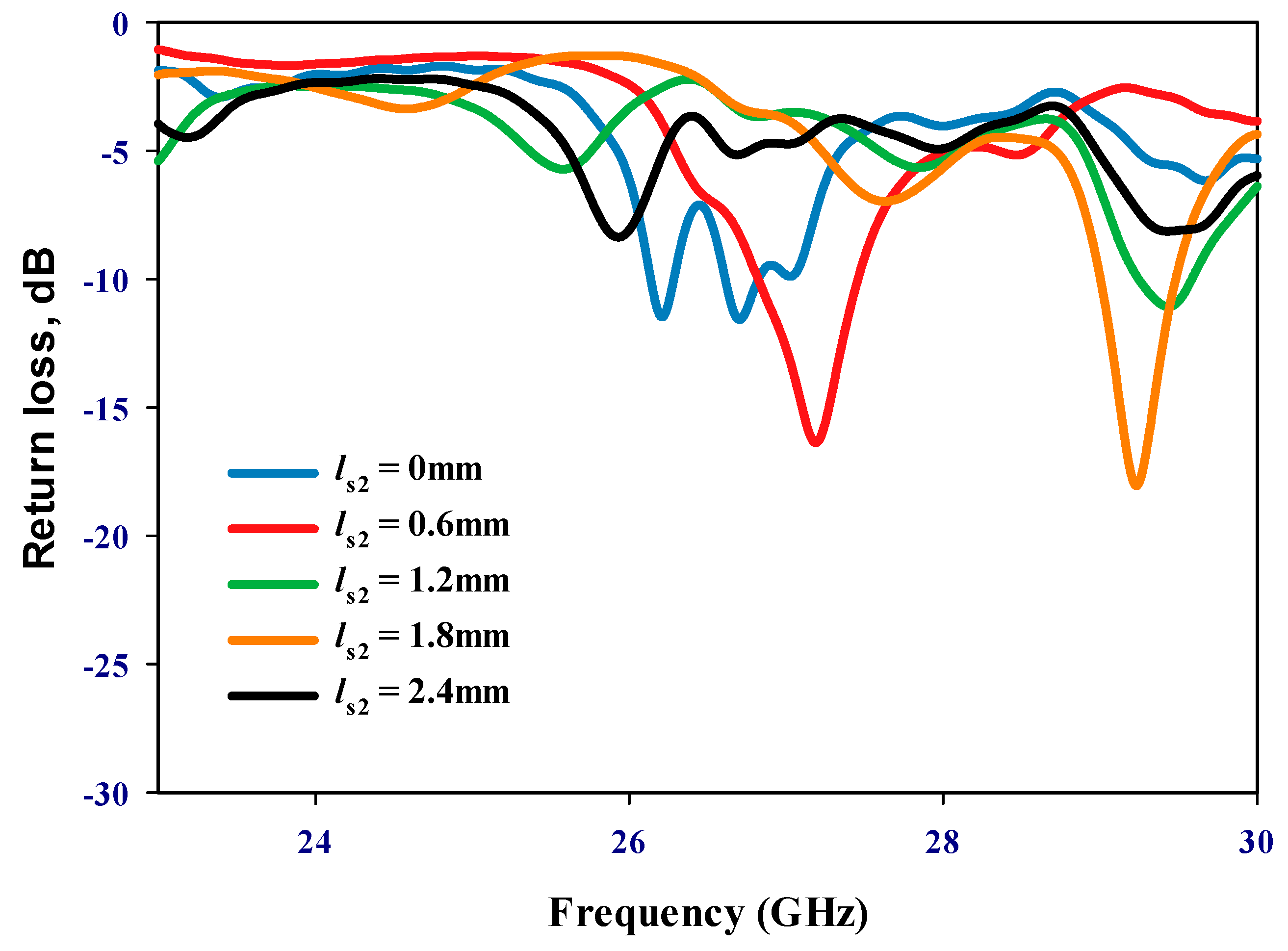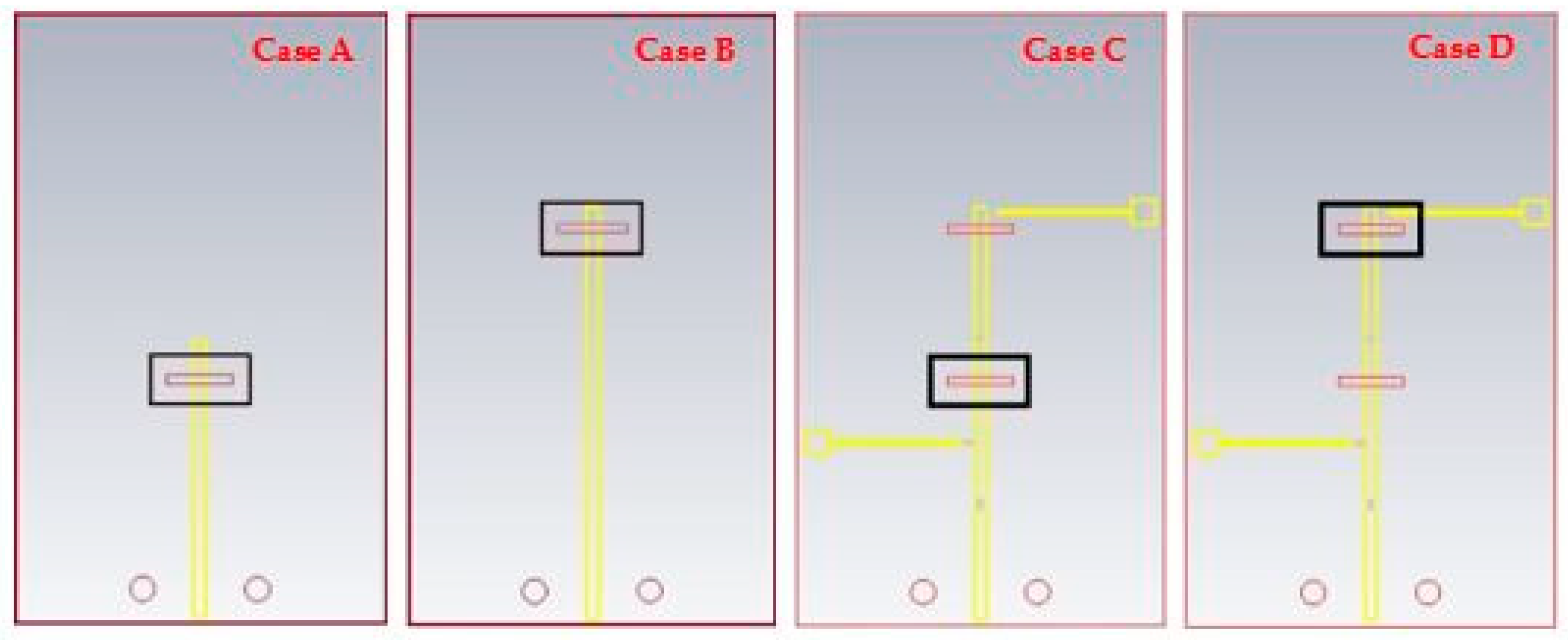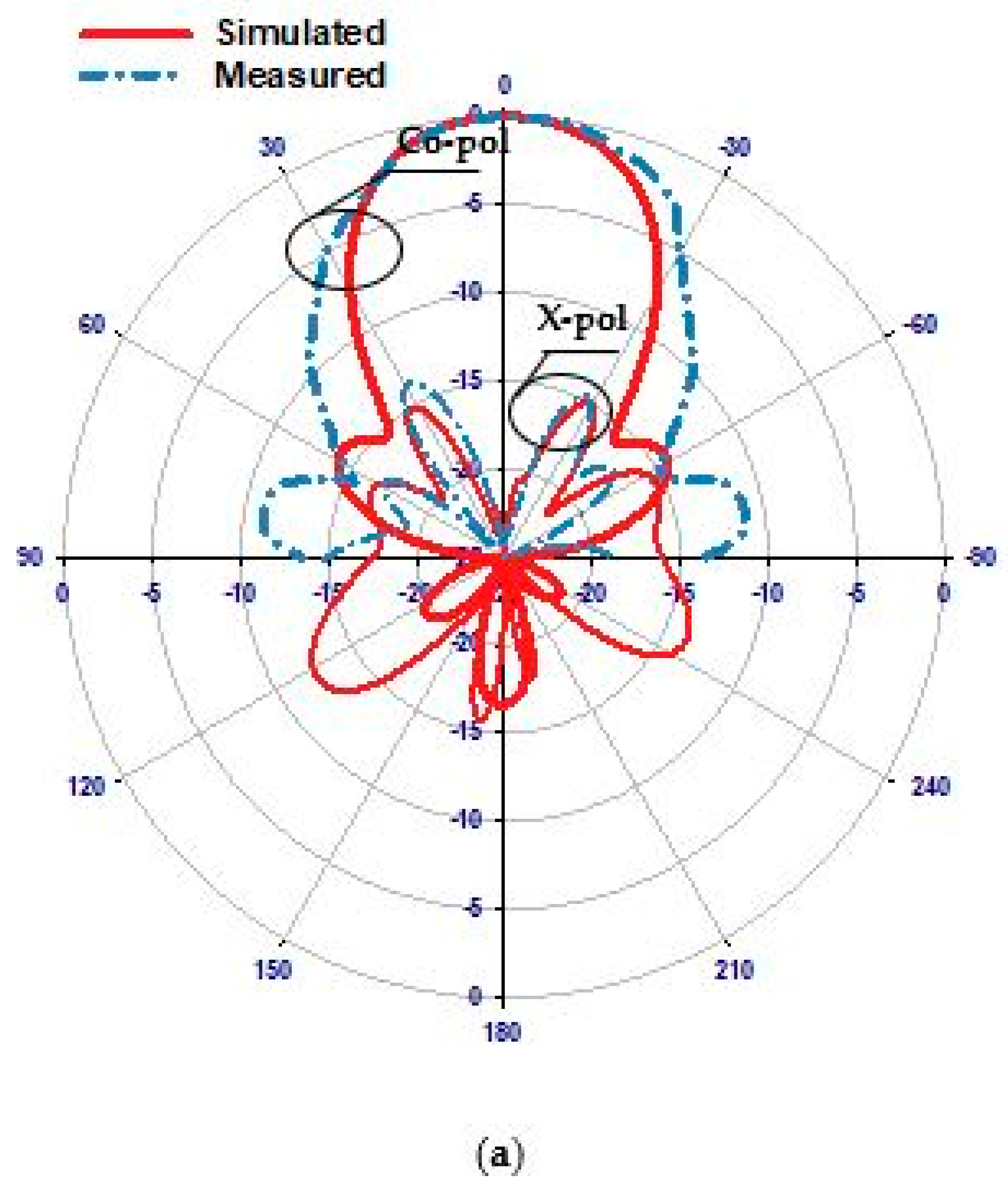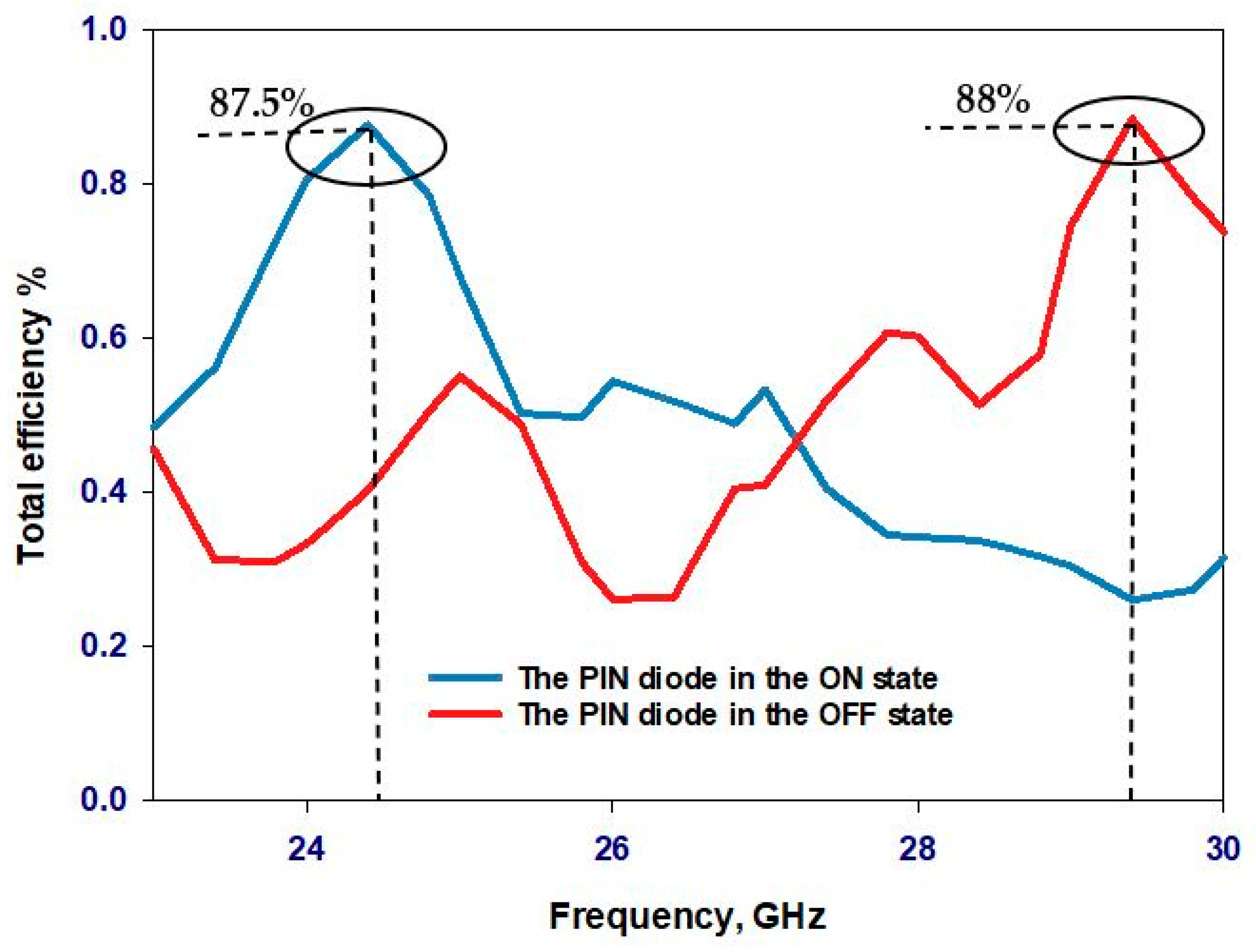Frequency-Reconfigurable Millimeter-Wave Rectangular Dielectric Resonator Antenna
Abstract
1. Introduction
2. Antenna Configuration
2.1. PIN Diodes and DC Biasing
2.2. Distance between the DRAs
2.3. Performance of a Single DRA
3. Results
3.1. OFF State Scenario
3.2. ON-State Scenario
4. Conclusions
Author Contributions
Funding
Institutional Review Board Statement
Informed Consent Statement
Data Availability Statement
Acknowledgments
Conflicts of Interest
References
- Christodoulou, C.G.; Tawk, Y.; Lane, S.A.; Erwin, S.R. Reconfigurable antennas for wireless and space applications. Proc. IEEE 2012, 100, 2250–2261. [Google Scholar] [CrossRef]
- Jong-Hyuk, L.; Gyu-Tae, B.; Young-Il, K.; Chang-Wook, S.; Tae-Yeoul, Y. A reconfigurable PIFA using a switchable PIN-diode and a fine-tuning varactor for USPCS/WCDMA/m-WiMAX/WLAN. IEEE Trans. Antennas Propagat. 2010, 58, 2404–2411. [Google Scholar] [CrossRef]
- Jusoh, M.; Sabapathy, T.; Jamlos, M.F.; Kamarudin, M.R. Reconfigurable four-parasitic-elements patch antenna for high-gain beam switching application. IEEE Antennas Wirel. Propag. Lett. 2014, 13, 79–82. [Google Scholar] [CrossRef]
- Li, H.; Ye, D.; Shen, F.; Zhang, B.; Sun, Y.; Zhu, W.; Li, C.; Ran, L. Reconfigurable Diffractive antenna based on switchable electrically induced transparency. IEEE Trans. Microw. Theory Tech. 2015, 63, 925–936. [Google Scholar] [CrossRef]
- Zou, C.; Withayachumnankul, W.; Bhaskaran, M.; Sriram, S.; Fumeaux, C. Dielectric resonator nanoantennas: A review of the theoretical background, design examples, prospects, and challenges. IEEE Antennas Propag. Mag. 2017, 59, 30–42. [Google Scholar] [CrossRef]
- Petosa, A.; Ittipiboon, A. Dielectric resonator antennas: A historical review and the current state of the art. IEEE Antennas Propag. Mag. 2010, 52, 91–116. [Google Scholar] [CrossRef]
- Singhwal, S.S.; Matekovits, L.; Kanaujia, B.K.; Kishor, J.; Fakhte, S.; Kumar, A. Dielectric Resonator Antennas: Applications and developments in multiple-input, multiple-output technology. IEEE Antennas Propag. Mag. 2022, 64, 26–39. [Google Scholar] [CrossRef]
- Danesh, S.; Rahim, S.K.A.; Abedian, M. Frequency reconfigurable dielectric resonator antenna for WiMAX/WLAN applications. Microw. Opt. Technol. Lett. 2015, 57, 579–582. [Google Scholar] [CrossRef]
- Wang, M.; Chu, Q.-X. A wideband polarization-reconfigurable water dielectric resonator antenna. IEEE Antennas Wirel. Propag. Lett. 2019, 18, 402–406. [Google Scholar] [CrossRef]
- Chen, Z.; Wong, H.; Kelly, J. A polarization-reconfigurable glass dielectric resonator antenna using liquid metal. IEEE Trans. Antennas Propag. 2019, 67, 3427–3432. [Google Scholar] [CrossRef]
- Danesh, S.; Rahim, S.K.A.; Abedian, M.; Hamid, M.R. A Compact frequency-reconfigurable dielectric resonator antenna for LTE/WWAN and WLAN applications. IEEE Antennas Wirel. Propag. Lett. 2015, 14, 486–489. [Google Scholar] [CrossRef]
- Ke, Y.-H.; Yang, L.-L.; Chen, J.-X. A pattern-reconfigurable dielectric resonator antenna based on switchable directors. IEEE Antennas Wirel. Propag. Lett. 2022, 21, 536–540. [Google Scholar] [CrossRef]
- Chen, J.-X.; Ke, Y.-H.; Yang, L.-L.; Yang, W.-W. Pattern-reconfigurable dielectric resonator antenna with endfire beam-scanning feature. IEEE Antennas Wirel. Propag. Lett. 2022, 21, 1398–1402. [Google Scholar] [CrossRef]
- Soltan, A.A.; Khamas, S.; Salman, S.M. A Polarization reconfigurable rectangular dielectric resonator antenna using PIN diode for X-band applications. Prog. Electromagn. Res. M 2023, 116, 1–10. [Google Scholar] [CrossRef]
- Ben Mabrouk, I.; Al-Hasan, M.; Nedil, M.; Denidni, T.A.; Sebak, A.-R. A novel design of radiation pattern-reconfigurable antenna system for millimeter-wave 5g applications. IEEE Trans. Antennas Propag. 2020, 68, 2585–2592. [Google Scholar] [CrossRef]
- Al-Hasan, M.J.; Denidni, T.A.; Sebak, A.R. Millimeter-wave FSS based dielectric resonator antenna with reconfigurable radiation pattern. In Proceedings of the 2014 IEEE Antennas and Propagation Society International Symposium (APSURSI), Memphis, TN, USA, 6–12 July 2014; pp. 1441–1442. [Google Scholar]
- Li, J.; Denidni, T.A.; Zeng, Q. High gain reconfigurable millimeter-wave dielectric resonator antenna. In Proceedings of the 2015 IEEE International Symposium on Antennas and Propagation & USNC/URSI National Radio Science Meeting, Vancouver, BC, Canada, 19–24 July 2015; pp. 444–445. [Google Scholar] [CrossRef]
- Soltan, A.A.; Abdulmajid, A.A.; Khamas, S.K. Optically controlled circularly polarized-reconfigurable millimeter-wave rectangular dielectric resonator antenna using photoconductive switches. In Proceedings of the 2022 16th European Conference on Antennas and Propagation (EuCAP), Madrid, Spain, 27 March–1 April 2022; pp. 1–5. [Google Scholar] [CrossRef]
- Rai, J.K.; Ranjan, P.; Chowdhury, R. Wideband frequency reconfigurable dielectric resonator antenna with defected ground plane for 5g millime-ter wave application. In Proceedings of the 3rd IEEE International Conference on Interdisciplinary Approaches in Technology and Management for Social Innovation (IATMSI), Virtual, 14–16 March 2024; pp. 1–4. [Google Scholar] [CrossRef]
- Mongia, R.K.; Ittipiboon, A. Theoretical and experimental investigations on rectangular dielectric resonator antennas. IEEE Trans. Antennas Propag. 1997, 45, 1348–1356. [Google Scholar] [CrossRef]
- MA4AGFCP910 Mouser Electronics. Available online: https://www.mouser.com/datasheet/2/249/MA4AGP907_FCP910-838114.pdf (accessed on 19 October 2023).
- T-Ceramics. Available online: http://www.t-ceram.com/ (accessed on 3 January 2023).
- Wrekin Circuits, Ltd. Available online: https://www.wrekin-circuits.co.uk/ (accessed on 9 November 2023).
- UKRI National Millimetre Wave Facility. Available online: https://www.sheffield.ac.uk/mm-wave/ (accessed on 9 November 2023).
- Alhamad, R.; Almajali, E.; Mahmoud, S. Electrical Reconfigurability in Modern 4G, 4G/5G and 5G Antennas: A critical review of polarization and frequency reconfigurable designs. IEEE Access 2023, 11, 29215–29233. [Google Scholar] [CrossRef]
- Choi, J.; Park, J.; Youn, Y.; Hwang, W.; Seong, H.; Whang, Y.N.; Hong, W. Frequency-adjustable planar folded slot antenna using fully integrated multithrow function for 5G mobile devices at millimeter-wave spectrum. IEEE Trans. Microw. Theory Tech. 2020, 68, 1872–1881. [Google Scholar] [CrossRef]
- Da Costa, I.F.; Cerqueira, A.; Spadoti, D.H.; Da Silva, L.G.; Ribeiro, J.A.; Barbin, S.E. Optically controlled reconfigurable antenna array for mm-wave applications. IEEE Antennas Wirel. Propag. Lett. 2017, 16, 2142–2145. [Google Scholar] [CrossRef]
- Patriotis, M.; Ayoub, F.N.; Tawk, Y.; Costantine, J.; Christodoulou, C.G. A millimeter-wave frequency reconfigurable circularly polarized antenna array. IEEE Open J. Antennas Propag. 2021, 2, 759–766. [Google Scholar] [CrossRef]
- Li, M.; Jamal, M.Y.; Li, X.; Yeung, K.L.; Jiang, L.J.; Itoh, T.; Murch, R.D. A millimeter-wave frequency-reconfigurable Fabry–Pérot cavity antenna. IEEE Antennas Wirel. Propag. Lett. 2022, 21, 1537–1541. [Google Scholar] [CrossRef]
- Ghassemiparvin, B.; Ghalichechian, N. Paraffin-based reconfigurable antenna operating at 100 GHz. J. Microelectromech. Syst. 2020, 29, 621–628. [Google Scholar] [CrossRef]
- Chen, Y.; Guo, H.; Liu, Y.; Li, J.; Zhan, Y.; Wu, Q.; Li, M. An L-Slot Frequency Reconfigurable Antenna Based on MEMS Technology. Micromachines 2023, 14, 1945. [Google Scholar] [CrossRef]
- Asfour, R.; Khamas, S.K.; Ball, E.A. Cost-Effective Design of Polarization and Bandwidth Reconfigurable Millimeter-Wave Loop Antenna. Sensors 2023, 23, 9628. [Google Scholar] [CrossRef] [PubMed]



















| (GHz) | (GHz) | Resonance Mode | |
|---|---|---|---|
| 1 | 24.3 | 25 | TE311 |
| 2 | 29.3 | 30.2 | TE513 |
| Ref | Antenna | Switch | ∆ (%) | Gain (dBi) |
|---|---|---|---|---|
| [26] | Slot | PIN diode | 2.47 | 6.4 |
| [27] | 4-slot array | Photoconductive | 30.3 | 9.0 |
| [28] | 16-patch array | Two PIN diodes | 24 | 12 |
| [29] | Fabry–Pérot | Mechanical | 8.5 | 22 |
| [30] | Slot | Mechanical | 7 | 3 |
| [31] | L-Slot | RF MEMS | 28 | 7.9 |
| [32] | Loop | Two PIN diodes | 4 | 7.2 |
| This work | Two DRAs | PIN diode | 20 | 11.8 |
Disclaimer/Publisher’s Note: The statements, opinions and data contained in all publications are solely those of the individual author(s) and contributor(s) and not of MDPI and/or the editor(s). MDPI and/or the editor(s) disclaim responsibility for any injury to people or property resulting from any ideas, methods, instructions or products referred to in the content. |
© 2024 by the authors. Licensee MDPI, Basel, Switzerland. This article is an open access article distributed under the terms and conditions of the Creative Commons Attribution (CC BY) license (https://creativecommons.org/licenses/by/4.0/).
Share and Cite
Soltan, A.; Asfour, R.; Khamas, S.K. Frequency-Reconfigurable Millimeter-Wave Rectangular Dielectric Resonator Antenna. Sensors 2024, 24, 3906. https://doi.org/10.3390/s24123906
Soltan A, Asfour R, Khamas SK. Frequency-Reconfigurable Millimeter-Wave Rectangular Dielectric Resonator Antenna. Sensors. 2024; 24(12):3906. https://doi.org/10.3390/s24123906
Chicago/Turabian StyleSoltan, Akrem, Rawad Asfour, and Salam K. Khamas. 2024. "Frequency-Reconfigurable Millimeter-Wave Rectangular Dielectric Resonator Antenna" Sensors 24, no. 12: 3906. https://doi.org/10.3390/s24123906
APA StyleSoltan, A., Asfour, R., & Khamas, S. K. (2024). Frequency-Reconfigurable Millimeter-Wave Rectangular Dielectric Resonator Antenna. Sensors, 24(12), 3906. https://doi.org/10.3390/s24123906






